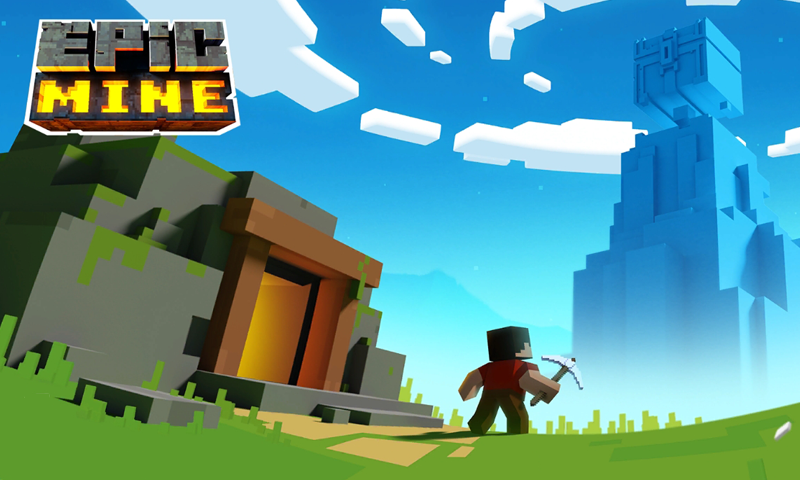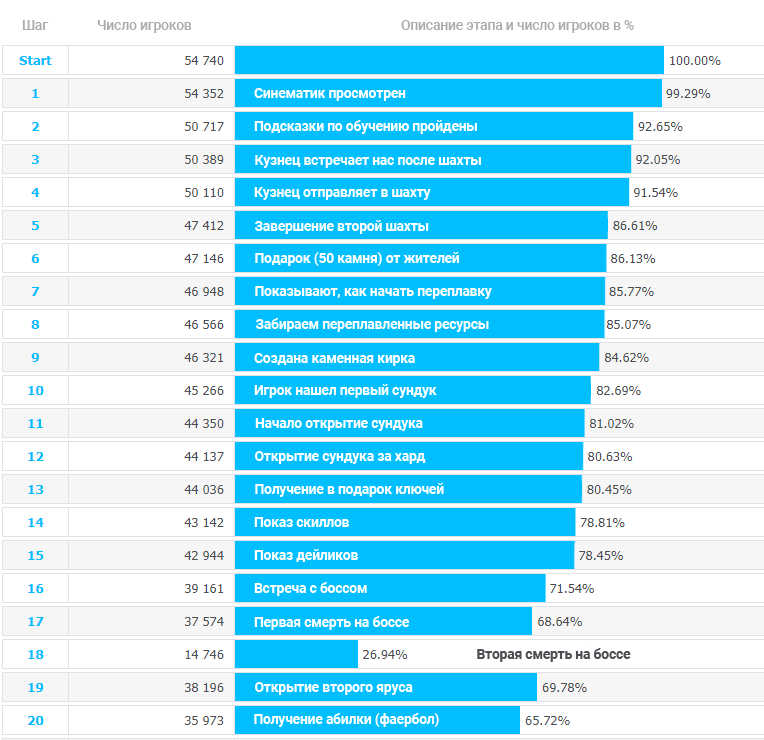Case study: how the authors of Epic Mine with devtodev improved the conversion of the tutorial from 29% to 65%
Nikita Belchak, a game designer at Black Temple Studio, and Vasily Sabirov, a leading analyst and cofounder at devtodev, told how they managed to double the conversion of the Epic Mine tutorial.

Studio and project
Black Temple is a small St. Petersburg studio. It consists of four people. Two of them are popular bloggers. One YouTube channel has more than 300 thousand subscribers, the other has 2.6 million.
Epic Mine is their fourth project. It can be called casual. The game is designed for Minecraft fans, young players up to 16 years old.
Core gameplay
The core of the game is mining ore in a mine. The essence of the gameplay boils down to the need to tap on the screen in time when the game sight coincides with the burning dots. Thus, the player destroys obstacles in the way of the hero and extracts resources, as well as finds chests and opens new mines.

Meta-gameplay
Meta games — resource management in the village. Here the player melts the obtained resources into ingots, creates new picks and cracks chests. You can’t get the keys without breaking the chests. The latter are necessary for the opening of new tiers with new mines.

The mines are grouped by tiers. There are six mines in one tier. To move to the next tier, you need to defeat the boss and open the stone door in the last mine. To open the doors, you just need the keys from the chests.

First launch
The first launch of the game was planned by the studio in the mobile stores of Belarus. To better understand how players will react to the project and how they will behave in it, the studio has integrated the SDK of the devtodev analytical service into it.
At the softlonch stage, the team was primarily concerned about the funnel of the tutorial. They knew that it was at this stage that it was possible to maximize the retention of the first day.
Recall that this is one of the key parameters for any game. Only if it is high, it makes sense to set up other metrics and elements of the game, because if users are not ready to return to the game after the first session, then it makes no sense to edit everything else (monetization, graphics, balance at the conditional tenth level, and so on).
As part of the Epic Mine training, the player completely passes one tier (six mines). In between, he learns how to create picks, remelting resources, leveling skills and hacking chests.
In the first version of the game , the funnel of the tutorial was as follows:

On the chart, we have marked four main places of the “dump” of players, not counting the stages with the boss.

Based on the results of studying the report, hypotheses were formed about what is wrong in the game.
1) The beginning of the game is too demanding for reaction (at the same time, it seemed to the developers that the game at the beginning “couldn’t be simpler”).
2) A sharp jump in complexity between the introductory mine and the one that must be completed entirely independently. In the first there were five walls that needed to be destroyed, and in the second there were 10 at once.
3) Those who passed the second mine did not see the point of digging in the third, although according to the plan they had to find the first chest there.
4) After the third mine, people lost interest and motivation to go further, because there the game no longer “led them by the handle”. The developers hoped that it would be interesting for the players to reach the end of the tier themselves.
5) The boss is too complicated.
What happened next?
Then the developers found the Epic Mine letsplays and saw a few more problems.
For example, the players did not understand that the main way to earn money was to melt ore into ingots and then sell them. The developers have added information about this in the training.
Another problem was in the non-intuitive system with picks. The team wanted players to craft picks that they liked in appearance, and as rarely as possible discarded one pick in favor of another just because of the characteristics. Therefore, all the picks were divided into several groups. In each group, the picks had the same coefficient by which the player’s damage was multiplied. The damage depended on the power that was pumped for gold and resources.

However, the players thought that the main way to upgrade was to make new picks. And they were very upset when, having spent time and resources on creating a new pickaxe, they did not receive a noticeable increase in damage.
I had to redo it. Now the damage is 80% dependent on the pickaxe, and each pickaxe now has the required strength level. The main game cycle now looks like this:
Breaking walls > Mining resources > Making a more powerful pickaxe > Breaking stronger walls
Another drawback is the initially incomprehensible system for obtaining stars.
After passing the mine to the end, she had three empty stars. Stars were earned by re-passing the mine, which after the initial passage became infinite. And the more walls the player breaks, the more stars he gets.
Now everything is different. The number of stars depends on the accuracy of the passage: the more lives left by the end of the mine, the more stars. However, the developers have not yet made any explanation inside the game, exactly how to get stars. But now players at least get stars when passing and, judging by the new letsplays, they themselves guess what they are given for.
As a result, having accepted all the hypotheses, the developers went to correct all the controversial points. After a few iterations to finalize the training , the funnel began to look like this:

The blade was smoothed out at four problematic steps. The total conversion rate has increased to almost 66%.
This result was achieved thanks to the changes made.
What exactly was done:
- the complexity began to increase very smoothly;
- now the game leads the player “by the handle” until the very end of training;
- arrows were added in those places about which the developers previously thought that “they will see, they will click”;
- there is a lock screen when the player can go somewhere wrong;
- dialogues and tasks have been added to the “boring” places;
- the boss can no longer be killed “on the move” — you need to pump up. After that, the boss is spread out on one or two. So the importance of pumping is additionally fixed in front of the player, which was previously just shown once on the village screen.
When searching for problem areas, analytics and video were equally important. The first one allowed us to accurately identify problem areas. The second is to explain what is wrong with them.
Once again, we note that the optimization of retention (especially short-term) must begin with the optimization of the first session. This, as a rule, is not very time-consuming or resource-intensive. At the same time, it almost immediately leads to an increase in business metrics.
In the case described, correcting the tutorial took only a few weeks, but the developers managed to increase the proportion of players remaining in the game by more than twice.
